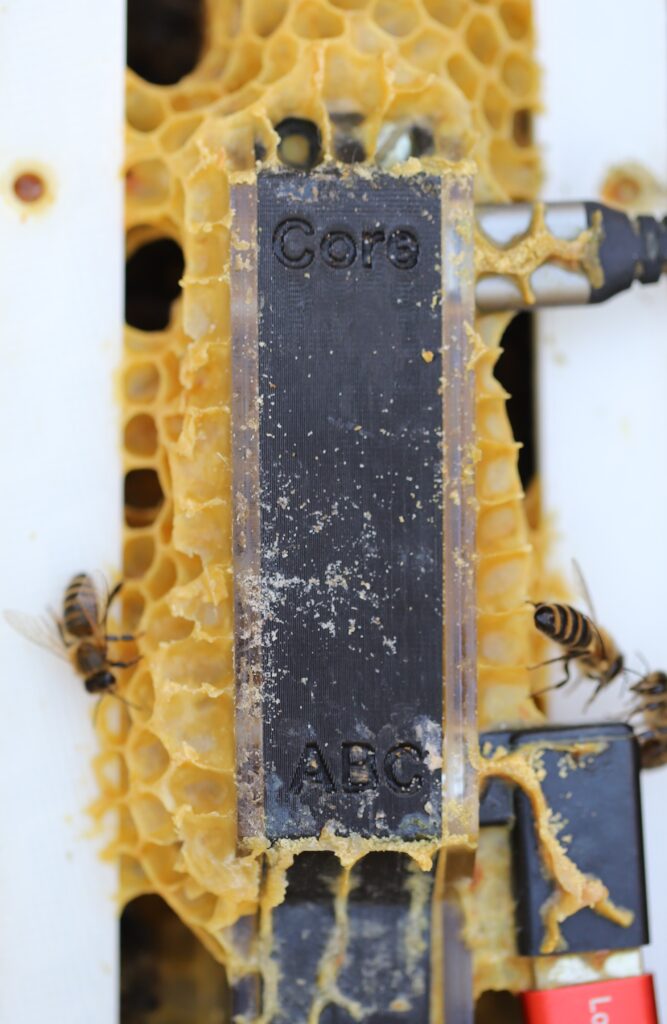We are thrilled to announce that the European Commission has selected our project for a one-year showcase at the Piazza Project, Communication Parcours, located in the Berlaymont, the main building of the European Commission. The HIVEOPOLIS project, supported by the EU H2020 FET-Proactive program (grant no. 824069), combines biohybrid superorganisms with advanced artificial life technologies. Conducted from 2019 to 2024, our project investigated methods of actively supporting the honeybees from within their nest environment through living fungal materials for their nest enclosures, ubiquitous temperature sensing, and local heating systems.

Featured in this exhibit is a cross-section of a full beehive, from the ground level to the top layer, demonstrating the use of a 3D printing technique that allows continuous deposition of organic materials—in this case, wood infill biopolymer—for structural scaffolding living materials—in this case, mycelial composites. The adjacent Digital Brood Comb component consists of 64 microsensors placed in a hexagonal comb structure where the queen bee deposits her eggs and the larvae are raised. These sensors transmit thermal information from this vital section of a honeybee nest to a user interface, allowing for human-honeybee interaction without mechanical disturbance of their comb structures: local heating adjustments without physically opening the hive, hence minimising disturbances to the bees.
The use of mycelium in the construction of the hive’s enclosure is a strategic response to the ecological impacts of monoculture practices in agriculture, as well as beehive construction with materials such as thin timber plates or polystrene, which endanger the diversity of symbiotic relationships required by honeybee colonies. The hive’s design and material structure are informed by computational models that emulate the geometrical parameters of natural honeybee habitats, such as hollow trees. Wood-decaying mycelial fungi, which help the formation of such tree cavities and share habitats with honeybees, act as a biological binder for diverse lignocellulosic waste materials in 3D scaffolds, which contain lignocellulosic components and provide critical thermal insulation. This biotechnological reconstruction also allows the hive to breathe through its pores and creates a bioreceptive environment that promotes the health and proliferation of honeybee symbionts.
–Post-HIVEOPOLIS, the mycelial bee habitats are further explored by design researcher Asya Ilgün in the Artificial Life Lab of the Institute of Biology, University of Graz. Dr. Ilgün received her doctorate through the case study of living architecture for honeybees in HIVEOPOLIS and her work, through design residencies and co-design workshops, continues to delve into the application of living architecture in honeybee and wild bee habitats. This engagement emphasises a practical and iterative approach to designing with mycelium, aligning ecological concerns with the practical needs of beekeeping as well as science-based wild bee hotels. Asya’s research focusses on the sustainability, adaptability, inclusivity, and distributed design of bee habitat structures, leveraging the biological properties of mycelium in-vivo to foster environments that support the complex symbiotic relationships within honeybee colonies.

READ THE LATEST DESIGN ARTICLE “Driving Design II” which is the sixth of seven publications from the Distributed Design Platform. Link to the open-access download page
READ ABOUT THE BIOLOGICAL AND MATERIAL SCIENCE RELATED ASPECTS HERE